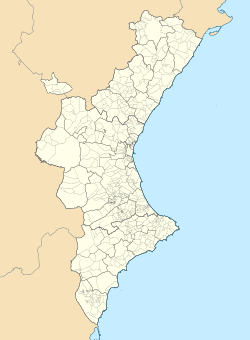|
Torrevieja
Torrevieja (Spanish: [toreˈβjexa] ; is a Mediterranean-seaside city and municipality on the Costa Blanca, in the province of Alicante, Valencian Community, in southeastern Spain. The city is in one of the only Spanish-speaking areas of the Valencian Community. Torrevieja lies about 50 kilometres south of the city of Alicante and had a population of around 90.1k residents as of the 2011 census; the latest official estimate (2019) is 83.3k inhabitants.[2] Torrevieja was originally a salt-mining and fishing village, as it is located between the Mediterranean Sea and two large pink salt lakes known as Las Salinas de Torrevieja. HistoryUntil the 1800s, Torrevieja was nothing more than random cottages and desolate dwellings near an ancient guard tower, which gave the town its name; torre vieja is Spanish for 'old tower'. In 1803, Charles IV decided to relocate the salt-mine production and offices from La Mata to the town of Torrevieja itself, allowing for the construction of new buildings and homes there. However, in 1829, the town was totally levelled by an earthquake, but the salt basins were soon recovered and business resumed. In the 19th century, the salt was mainly shipped from the town by Swedish and Dutch merchant and cargo ships. At the time, there was only limited salt exportation to other regions of Spain, mainly to Galicia and, to a lesser extent, greater Valencia. Soon, with the turn of the 20th century, a quarter of all the salt sold in Spain was harvested directly from the Torrevieja lagoons, with the rest being exported to foreign markets. Today, it is still an important industry in Torrevieja and still a major employer. The city features a Museum of Sea and Salt. In 1931, Alfonso XIII gave Torrevieja city status by special grant. During this period, there was also a growing market for locally-grown flax, hemp and cotton. The municipality contains a water desalination plant, the largest of its kind in Europe. The company that built the plant, Acconia, maintains that the plant supplies water for customers across Northern Europe.[3] Recent history Since the mid-20th century, and entering into the 21st century, the local economy has grown exponentially due to the Mediterranean tourism industry, attracting visitors from elsewhere in Spain as well as tourists from abroad. Additionally, there is a strong contingent of British, Irish, German and Scandinavian citizens who stay in Torrevieja year-round, as well as many extended-vacationers using companies like Air BnB, or property timeshares. There is also a growing number of Spaniards who own second homes in the city. In 2004, Torrevieja had the largest number of British expats of all the Spanish municipalities (approx. 7,180[citation needed]). The high number of British residents from Yorkshire has led to Torrevieja being nicknamed 'Costa del Yorkshire' by some,[4] and paella can be had served in giant Yorkshire puddings in many of the city's restaurants.[5] In 2001, the city was (along with Random House's Spanish subsidiary, Plaza & Janés) recognised with Spain's second-most important annual literary award, the Premio de Novela Ciudad de Torrevieja, and its poetry correlative, Premio de Poesía Ciudad de Torrevieja. ClimateKöppen-Geiger climate classification system classifies its climate as hot semi-arid (BSh),[6] with dry, mild winters and hot, very dry summers. October is the wettest month.
PopulationIn 1991, the city had 25,000 residents, two decades later close to 100,000. The father of the expansion was Pedro Ángel Hernández Mateo, mayor between 1988 and 2011. In order to encourage growth, all the land was rezoned fit for building, save for the two lagoons, designated natural parks in 1989.[10] The INE (Spanish Census) of 2005 showed that the city had 84,838 residents, and the ajuntament (district council area) had 95,531 residents. By January 2008 this figure had reached 103,154 of whom only 47,870 were Valencian or Spanish. More than 7,000 of the Spanish residents were originally from Madrid and not for nothing is Torrevieja known as la playa de Madrid (the beach of Madrid). However, by the 2011 census, the population had reduced to 90,097 and the latest estimate (for the start of 2019) is 83,337.[2]
The most prominent nationalities in 2012 were:[11]
PoliticsThe city is a conservative stronghold, with the Partido Popular (PP) maintaining an absolute majority at the municipal elections of 2007, and 2011. PP however narrowly lost its absolute majority in 2015 to a coalition of five parties which designated Green candidate José Manuel Dolón García mayor. TransportTorrevieja's main road link is the N-332 road linking Cartagena with Valencia hugging the Mediterranean coastline. There was once a branch line from the Alicante–Murcia railway serving Torrevieja; which closed in the late 1970s. There are plans to reopen this line.[12] Places of interest 
SportThe town was home to professional handball club CB Torrevieja since 1973 until its bankruptcy in 2012. They played at the Palacio de los Deportes de Torrevieja, where the 2012 Copa del Rey de Balonmano was hosted. The town also hosted the 2nd IHF Women's Handball Qualification Tournament for the 2024 Summer Olympics. The local football teams used to be Torrevieja CF and CD Torrevieja. In road cycling, the town was the starting point of the 2023 La Vuelta Femenina and the starting point of the 2019 Vuelta a España. Notable people
NotesReferences
External linksWikimedia Commons has media related to Torrevieja.
|
||||||||||||||||||||||||||||||||||||||||||||||||||||||||||||||||||||||||||||||||||||||||||||||||||||||||||||||||||||||||||||||||||||||||||||||||||||||||||||||||||||||||||||||||||||||||||||||||||||||||||||||||||||||||||||||||||||||||||||||||||||||||||||||||||||||||||||||||||||||||||





